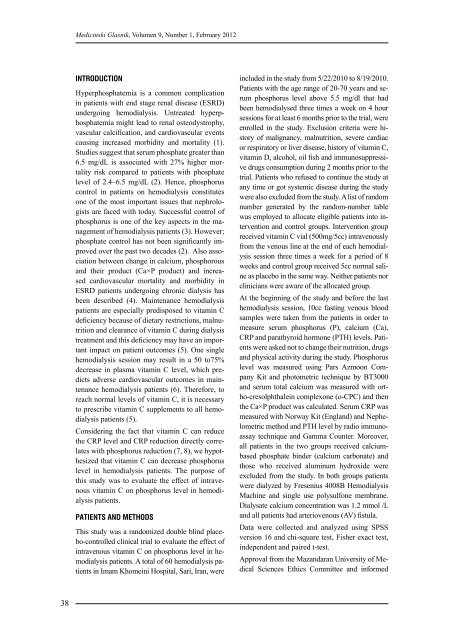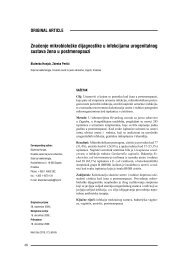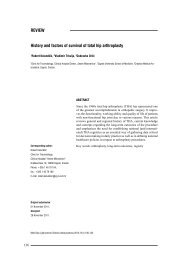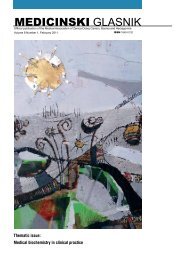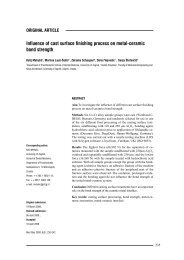MEDICINSKI GLASNIK
MEDICINSKI GLASNIK
MEDICINSKI GLASNIK
You also want an ePaper? Increase the reach of your titles
YUMPU automatically turns print PDFs into web optimized ePapers that Google loves.
38<br />
Medicinski Glasnik, Volumen 9, Number 1, February 2012<br />
INTRODUCTION<br />
Hyperphosphatemia is a common complication<br />
in patients with end stage renal disease (ESRD)<br />
undergoing hemodialysis. Untreated hyperphosphatemia<br />
might lead to renal osteodystrophy,<br />
vascular calcification, and cardiovascular events<br />
causing increased morbidity and mortality (1).<br />
Studies suggest that serum phosphate greater than<br />
6.5 mg/dL is associated with 27% higher mortality<br />
risk compared to patients with phosphate<br />
level of 2.4–6.5 mg/dL (2). Hence, phosphorus<br />
control in patients on hemodialysis constitutes<br />
one of the most important issues that nephrologists<br />
are faced with today. Successful control of<br />
phosphorus is one of the key aspects in the management<br />
of hemodialysis patients (3). However;<br />
phosphate control has not been significantly improved<br />
over the past two decades (2). Also association<br />
between change in calcium, phosphorous<br />
and their product (Ca×P product) and increased<br />
cardiovascular mortality and morbidity in<br />
ESRD patients undergoing chronic dialysis has<br />
been described (4). Maintenance hemodialysis<br />
patients are especially predisposed to vitamin C<br />
deficiency because of dietary restrictions, malnutrition<br />
and clearance of vitamin C during dialysis<br />
treatment and this deficiency may have an important<br />
impact on patient outcomes (5). One single<br />
hemodialysis session may result in a 50 to75%<br />
decrease in plasma vitamin C level, which predicts<br />
adverse cardiovascular outcomes in maintenance<br />
hemodialysis patients (6). Therefore, to<br />
reach normal levels of vitamin C, it is necessary<br />
to prescribe vitamin C supplements to all hemodialysis<br />
patients (5).<br />
Considering the fact that vitamin C can reduce<br />
the CRP level and CRP reduction directly correlates<br />
with phosphorus reduction (7, 8), we hypothesized<br />
that vitamin C can decrease phosphorus<br />
level in hemodialysis patients. The purpose of<br />
this study was to evaluate the effect of intravenous<br />
vitamin C on phosphorus level in hemodialysis<br />
patients.<br />
PATIENTS AND METHODS<br />
This study was a randomized double blind placebo-controlled<br />
clinical trial to evaluate the effect of<br />
intravenous vitamin C on phosphorus level in hemodialysis<br />
patients. A total of 60 hemodialysis patients<br />
in Imam Khomeini Hospital, Sari, Iran, were<br />
included in the study from 5/22/2010 to 8/19/2010.<br />
Patients with the age range of 20-70 years and serum<br />
phosphorus level above 5.5 mg/dl that had<br />
been hemodialysed three times a week on 4 hour<br />
sessions for at least 6 months prior to the trial, were<br />
enrolled in the study. Exclusion criteria were history<br />
of malignancy, malnutrition, severe cardiac<br />
or respiratory or liver disease, history of vitamin C,<br />
vitamin D, alcohol, oil fish and immunosuppressive<br />
drugs consumption during 2 months prior to the<br />
trial. Patients who refused to continue the study at<br />
any time or got systemic disease during the study<br />
were also excluded from the study. A list of random<br />
number generated by the random-number table<br />
was employed to allocate eligible patients into intervention<br />
and control groups. Intervention group<br />
received vitamin C vial (500mg/5cc) intravenously<br />
from the venous line at the end of each hemodialysis<br />
session three times a week for a period of 8<br />
weeks and control group received 5cc normal saline<br />
as placebo in the same way. Neither patients nor<br />
clinicians were aware of the allocated group.<br />
At the beginning of the study and before the last<br />
hemodialysis session, 10cc fasting venous blood<br />
samples were taken from the patients in order to<br />
measure serum phosphorus (P), calcium (Ca),<br />
CRP and parathyroid hormone (PTH) levels. Patients<br />
were asked not to change their nutrition, drugs<br />
and physical activity during the study. Phosphorus<br />
level was measured using Pars Azmoon Company<br />
Kit and photometric technique by BT3000<br />
and serum total calcium was measured with ortho-cresolphthalein<br />
complexone (o-CPC) and then<br />
the Ca×P product was calculated. Serum CRP was<br />
measured with Norway Kit (England) and Nephelometric<br />
method and PTH level by radio immunoassay<br />
technique and Gamma Counter. Moreover,<br />
all patients in the two groups received calciumbased<br />
phosphate binder (calcium carbonate) and<br />
those who received aluminum hydroxide were<br />
excluded from the study. In both groups patients<br />
were dialyzed by Fresenius 4008B Hemodialysis<br />
Machine and single use polysulfone membrane.<br />
Dialysate calcium concentration was 1.2 mmol /L<br />
and all patients had arteriovenous (AV) fistula.<br />
Data were collected and analyzed using SPSS<br />
version 16 and chi-square test, Fisher exact test,<br />
independent and paired t-test.<br />
Approval from the Mazandaran University of Medical<br />
Sciences Ethics Committee and informed


